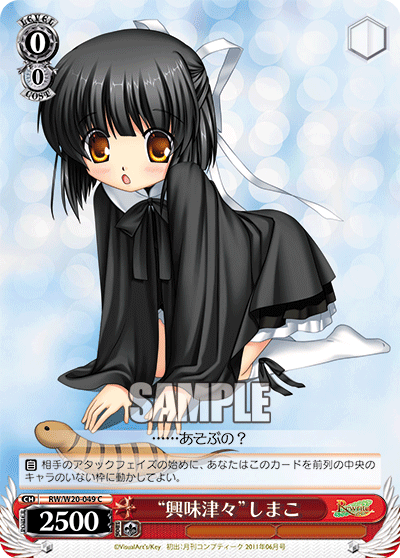The runner or Azusa profile is a very interesting field based profile. The runner itself is essentially any card that “runs” by fleeing to another spot on stage during the start of your opponent’s attack phase. There are many variants to the runner that define how and where it “runs” to.



SG/W19-001RR 全力の拳 響 (center)
RW/W20-049C “興味津々”しまこ (right)
The original “runner” profile was Azusa, the card to the left, a card from the original set of Idolm@ster back in 2009. She had a pretty painful condition with her first effect, but she was mainly ran for her second ability to freely escape to another slot on your front stage.
Due to the confliction with another Azusa profile which relates to the Akatsuki profile, the entire profile itself shall be called “runner” in this case.
Azusa is considered to be a free runner, a runner that can move anywhere on the front stage at the start of your opponent’s attack phase. Free runners generally have a bit lower power to other runners due to their ability to move to any front row slot without condition.
Other runner profiles eventually came onto the stage like the mill runner with the first being Hibiki from the first Symphogear set back in 2012. Similar to free runners, mill runners have the ability to run to any slot on the front stage. They also possess higher power usually, but they come with a condition. As their name implies, to achieve their running effect, you must mill their specific targets to gain the ability to move. This can be a bit of concern compared to free runners as they can fail and lose the ability to run. However, their mill condition can be used to the player’s advantage as a free way to mill the deck. Leaving the card in the backrow can lead to repetitive turns of free milling at the start of every opponent’s attack phase too (the run is optional).
Another profile that came to being was the center runner with the first being Shimako from the original Rewrite set back in 2010. The center runner carries a similar running ability to that of the free runner. However, the runner is restricted to just the center position of the front row only, meaning, ideally the card swings on a side lane so that it can move to the center during the opponent’s turn.



DAL/W79-076RR “レイニー・ガール”四糸乃 (center)
DG/S02-009U 極上のサルバトーレ (right)
There is another runner profile in the form of the front runner/chaser. Gray was the first form of the front runner back in the Fairy Tail extra booster set back in 2011. As the name implies, the runner runs in front of other targets, challenging an opponent’s card. This effect is seen as rather undesirable, as granted, in the early days of Weiss, as cards were rather power heavy, the power runner was not too much of a desirable effect. It was also rather rare as a profile itself. But nowadays, given the large amount of filter and tech/utility cards floating around in most players’ level zero line-ups, the front runner has become a more popular choice as it can easily survive a challenge against these low powered level zeros.
In addition, one new runner profile has started becoming printed in the form of the fleeing runner. There’s no full community name as far as I know it for now, but it is a profile that is becoming rather popular. The first known version of it appears as the Yoshino above in the Date A Live booster set back in 2019. The runner performs a little differently from the other runners as it “flees” from the card it is facing at the start of the opponent’s attack phase. It’s similar to the front runner/chaser but in reverse.
One other runner-esque effect to consider is the anti-runner. The anti-runner, as the name implies, prevents cards from running to different parts of the stage. Keep in mind that the anti-runner itself is not normally a runner. Anti-runners, just like the front runner/chaser, was not a very popular profile either during the early start of the game. Just as runners were rare, anti-runners found very little purpose except for a niche use against these profiles. Even now, the anti-run ability should be considered a secondary ability tacked on an already useful profile. Given in the right scenarios, the anti-runners can be quite detrimental to any player running runners, helping to keep them in check.
Overall, runners are a unique utility choice in the early game that has potential to really change the ways in which your opponent plans out their field. Use them to save another resource for the following turn or to force your opponent to decide whether to crash/side your cards for lost beneficial value.